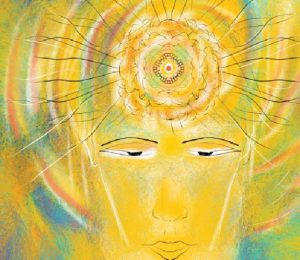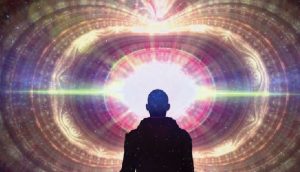From a purely spiritual perspective, there are three main doctrines. One is monotheism, second is dualism and the third one put forward by Swami Dayanand Saraswati envisages a tripod of the Supreme Being, the soul and nature called material radica (nature). Again the elusiveness of Maya is discernible when each of these three concepts seem very real and plausible when explained by various seers in their respective spheres of influence, and yet remain abstract as ever.
Advaita Vedanta
According to Jeevanmukta Avakash, Advaita Vedanta, a Jivmukta, or one who has been liberated here and now, has realized that Brahman alone is real and the world is illusion. Therefore, one could argue that the experience of a Brahmin should not involve awareness of the physical body or the world around it. But the continuity of the physical body or samsara is not inconsistent with the idea of liberation according to Advaita Vedanta. But after liberation, one definitely thinks of himself as a body.
After liberation, however, one realizes that there is only a deceptive presence in the physical body and the world. Although they seem to exist they do not really exist. Advaita Vedanta is only one point of view from the point of view of liberation. Since the physical body is not real, its continuous form, or its eventual disappearance, is not a problem for the biographer. For Jeevatamukta, the body and the world are like a dream. The only difference between an ordinary dreamer and a life-maker is that the person dreaming while dreaming does not know that it is a dream. But a jivamukta always knows that he is a dreamer.
Dvaita vedanta
The dualistic school of the Vedanta system, or the school of dvaita-vada, also called Samvat-swatram-vad developed by Madhava (also known as Anandatirtha), teaches that God (Saguna Brahma), the individual souls ( Jiva), and the world (Jagat) are eternally different from each other, and they are all real. Even when separated, organisms become part of Brahm. In relation to God, the organism is like an atom (anu). God is free, but beings and worlds are not. They depend on God. According to this school, God is the supreme deity, Vishnu, who is the creator of this world, constant and destructive… He is the efficient cause of this world, while Mother Nature or Nature is its physical cause.
 The school believes. Postmortem salvation only. It does not believe in liberation. In ascending order, this school believes in the four levels of salvation: (1) Salokya, (2) Samyapya, (3) Suryapya and (4) Satyajyaya. … In Salokyamukti, the departed soul goes to Ish-loka (the abode of Vishnu) and stays there, enjoying his presence.
The school believes. Postmortem salvation only. It does not believe in liberation. In ascending order, this school believes in the four levels of salvation: (1) Salokya, (2) Samyapya, (3) Suryapya and (4) Satyajyaya. … In Salokyamukti, the departed soul goes to Ish-loka (the abode of Vishnu) and stays there, enjoying his presence.
In Samyak-mukti, the departed soul enjoys extreme closeness to Vishnu. In the sarupya-mukti, the departed soul attains the form of Vishnu and attains intense bliss. In the Sāyujya-mukti, the departed soul rejoices in Vishnu.
Swami Dayanand Saraswati opines that God has no form. He, who has a body(form) cannot be God, because such a being would have finite capacity, special and temporal limitations, hunger, thirst, wear and tear, cold and heat, fever, diseases, etc. These attributes can hold good only in case of souls and not of God. Just as we people have a form i.e., we have bodies and for that reason, we have no control over tri-atoms, di-atoms or materia-radica(finest elements). Similarly, if God had a gross body, it would has been impossible for him to make the world out of those fine elements. Being free from material sense-organs or hands, feet and other members of the body, and possessing infinite energy, power and activity he can do those things which the souls and materia-radica (nature) cannot do. As God is finer than materia-radica (nature) and pervades it, he can take it into his grip and transform it into universe.
After having made a brief reference to the three distinct perspectives of spirituality, which are more in the nature of an esoteric facet of Maya, now the very fascinating exoteric face of Maya, which has always held me spellbound and wondering, shall be shared with you all. It is common knowledge that all things are made of atoms — little particles that move around in perpetual motion, attracting each other when they are a little distance apart, but repelling upon being squeezed into one another.
Atoms are made up of particles called protons, neutrons, and electrons, which are responsible for the mass and charge of atoms. In this one sentence the most valuable information on scientific knowledge explains the atomic riddle. Needless to say that the atoms have a nucleus, which comprises protons and neutrons bound together. Around this nucleus shells of electrons spin, and each shell is either full or trying to get full, to balance with the number of protons — to balance the number of positive and negative charges.
An atom is the smallest unit of matter that retains all of the chemical properties of an element. Atoms combine to form molecules, which then interact to form solids, gases, or liquids. For example, water is composed of hydrogen and oxygen atoms that have combined to form water molecules. Many biological processes are devoted to breaking down molecules into their component atoms so they can be reassembled into a more useful molecule.
Atoms consist of three basic particles: protons, electrons, and neutrons. The nucleus (centre) of the atom contains the protons (positively charged) and the neutrons (no charge). Protons and neutrons have approximately the same mass, about 1.67 × 10-24 grams, which scientists define as one atomic mass unit (amu) or one Dalton. The outermost regions of the atom are called electron shells and contain the electrons (negatively charged). Each electron has a negative charge (-1) equal to the positive charge of a proton (+1). Neutrons are uncharged particles found within the nucleus.
Atoms have different properties based on the arrangement and number of their basic particles. The atomic number is the number of protons in an element, while the mass number is the number of protons plus the number of neutrons. Isotopes are various forms of an element that have the same number of protons, but a different number of neutrons. The hydrogen atom (H) contains only one proton, one electron, and no neutrons. This can be determined using the atomic number and the mass number of the element (see the concept on atomic numbers and mass numbers).
An atom without any electric charge is so elusive that unless more than a million many times over are present we have no sufficiently sensitive means to detect them, or to express it in another way, a billion un-electrified atoms may escape our observation, whereas a dozen or so electrified ones are detected without difficulty. In size the electron bears the same relation to an atom that a baseball bears to the earth. Or as one scientist puts it, if a hydrogen atom were magnified to the size of a church, an electron would be a speck of dust in that church.
 Shortly after electrons were discovered it was thought that atoms were like little solar systems, made up of a … nucleus and electrons, which went around in “orbits,” much like the planets … around the sun. Recognize that the very molecules that make up your body, the atoms that construct the molecules, are traceable to the crucibles that were once the centres of high mass stars that exploded their chemically rich guts into the galaxy, enriching pristine gas clouds with the chemistry of life.
Shortly after electrons were discovered it was thought that atoms were like little solar systems, made up of a … nucleus and electrons, which went around in “orbits,” much like the planets … around the sun. Recognize that the very molecules that make up your body, the atoms that construct the molecules, are traceable to the crucibles that were once the centres of high mass stars that exploded their chemically rich guts into the galaxy, enriching pristine gas clouds with the chemistry of life.
So that we are all connected to each other biologically, to the earth chemically and to the rest of the universe atomically. That’s kinda cool! That makes me smile and I actually feel quite large at the end of that. It’s not that we are better than the universe, we are part of the universe. We are in the universe and the universe is in us. Saying that each of two atoms can attain closed electron shells by sharing a pair of electrons is equivalent to saying that husband and wife are having a total of two lakh rupees in a joint account and if each has six lakh rupees in an individual bank account, it would mean that individually each has eight lakh rupees!
If the atoms in [a] decimetre cube of lead were all put into a chain side by side the same distance apart as they are in the normal lead, the strings of atoms so formed would reach over six million miles. If molecules can be structurally identical and yet possess dissimilar properties, this can be explained only on the ground that the difference is due to a different arrangement of the atoms in space.
Never believe that the atom is a complex mystery — it is not. The atom is what we find when we look for the underlying architecture in nature, whose bricks are as few, as simple and orderly as possible. As we carry on understanding the invisible world of atoms through this series more and more revelations of how this hidden cause produces a visible effect. Presently with the good and bad effects of corona pandemic being felt the world over, it will be fascinating to allude this chain of events to the elusive world of MAYA.
letters@tehelka.com













